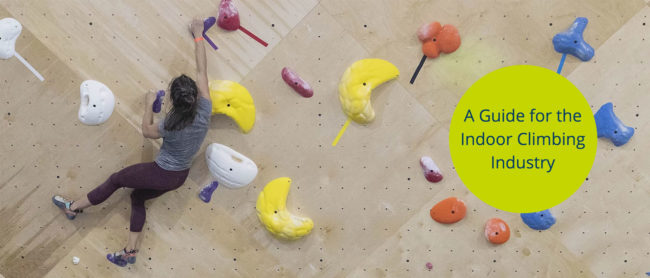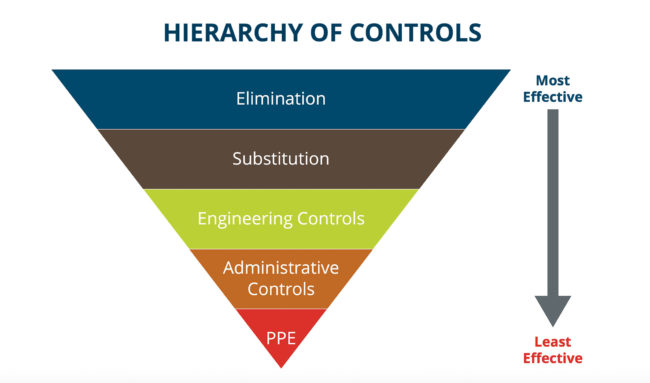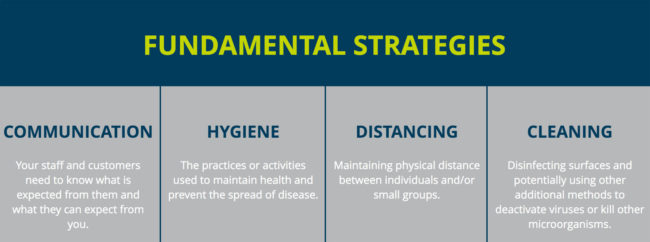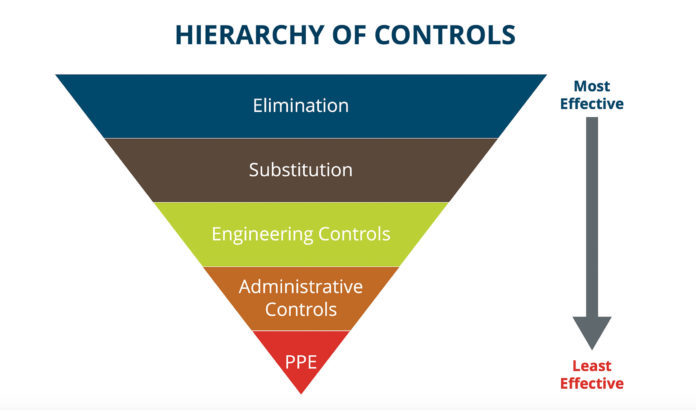
By John Burgman
The Climbing Wall Association (CWA) recently released a comprehensive online packet with information and strategies for climbing gym reopenings in the midst of the Coronavirus (COVID-19) pandemic. The new guide from the Boulder, Colorado-based association, packaged as the “Roadmap to Reopening,” comes as more gyms around the country reopen with various mitigation strategies intended to reduce the risk and spread of the virus. CBJ first reported an initial wave of gym reopenings around the first week of May.
Much of the information in the CWA’s new guide aligns with mitigation efforts that many reopened gyms have already implemented. “First, identify the authorities relevant to your location or locations,” advises the CWA. “Follow rules from every level of government, city to national, and examine the sources of their rules and recommendations; distinguish what is required from what is optional.”

Hierarchy of Controls
The guide begins by explaining a broad “Hierarchy of Controls” that relates to operating a business amid any hazard. The levels of the hierarchy include various strategies such as completely removing the hazard (“elimination”), replacing the hazard with something less hazardous (“substitution”), changing workplace practices to protect people from the hazard (“administrative controls”), and other methods of control.
Hygiene
More specific to climbing gym operations is the section of the guide titled, “Fundamental Strategies,” wherein the CWA lists various possible protocols—and in some cases states what gyms should or should not do. For example, under the category of Hygiene, the guide notes that face masks may be used in a gym and also advocates that customers should not touch their face while climbing. Other recommendations include: Customers should limit the number of partners that they climb with to either household members or a select few partners, and customers should not go to the gym if they have recently been in contact with an individual at high-risk for COVID-19.
Physical Distancing
In the section about Physical Distancing, the CWA urges occupancy limits. “There are many ways to regulate the number of people in your gym at any given time,” states the guide. “Before choosing a method consider how it will affect your business model, your community’s perception of your gym, and your future operations.” The CWA also advises gyms to consider lowering areas, fall zones and walkways when planning and setting routes and encouraging social distancing.
Cleaning
Under the Cleaning section, the CWA acknowledges that “holds and walls cannot be cleaned between ascents or daily in a manner that eliminates transmission risk” in its totality. However, the CWA guide does provide recommendations such as the wearing of masks, gloves and eye protection by routesetters when stripping walls and storing holds.

Communication
In the Communication section, the CWA offers strategies when developing a communication plan, since “staff and customers need to know what is expected from them and what they can expect from you.” In addition to Customer and Staff Communication, this section also includes strategies for Facility-Level Communication―like waiver agreements and signage―and Public Communication. The latter encompasses local health authorities, and it is encouraged to “maintain a constant dialogue of best practices and current conditions” with them.
Regional Differences
The guide is not intended to be applied uniformly to all gyms. The CWA acknowledges that “each of us will face unique situations and no recommendations will encompass all the challenges you will face.” CBJ encourages gym operators to read the CWA’s guide to reopening in full, which can be found here.

John Burgman is the author of High Drama, a book that chronicles the history of American competition climbing. He is a Fulbright journalism grant recipient and a former magazine editor. He holds a master’s degree from New York University and bachelor’s degree from Miami University. In addition to writing, he coaches a youth bouldering team. Follow him on Twitter @John_Burgman and Instagram @jbclimbs. Read our interview Meet John Burgman, U.S. Comp Climbing’s Top Journalist.








